The closest thing to a panacea for today's market uncertainties may be Down Under. In virtually every respect, Australia offers investors the best of all worlds.
It's true even for very safe short-term yields (which are currently microscopic in the U.S.) In mid-June, one-year AAA-rated Australian government treasury bonds yielded 4.45%, 416 basis points more than U.S. Treasurys with similar maturities.
This huge spread is not caused by some Greek drama unfolding in Australia. On the contrary, Australia has perhaps the healthiest developed market economy. The country is resource rich and has one of the highest-ranked business environments anywhere. Unemployment is relatively low, consumers are spending, and so is China-Australia's top importer.
The country has enjoyed more than 17 uninterrupted years of economic growth where expansion has averaged more than 3% a year. And the economy sidestepped the banking and housing crisis the rest of the world's major markets were mired in during 2008 and 2009. According to the Economist Intelligence Unit, the country's housing prices have held close to the historic peaks they hit in 2007. And with virtually no subprime exposure and manageable loan arrears, Australia's banks have not only remained profitable throughout the global banking crisis, but unlike U.S. banks, they continue to lend-and that supports growth.
Rising Rates
So impressive has been the country's economic resilience that the Reserve Bank of Australia was the first major central bank to start bumping up overnight rates. It has done so six times since last fall-25 basis points at a clip-sending official rates up to 4.50%. This is a testament to the central bank's long-term commitment to keep a lid on inflation. For decades, interest rates have been generally higher there than in the rest of the developed world. So investors shouldn't blink at these sweet yields.
Chuck Butler, president of St. Louis-based Everbank World Markets, thinks the Australian overnight rates will head up to 5% by year's end. That means investors looking to park money in Sydney might want to stay with short-term maturities to avoid the sinking price that would accompany rising rates.
Everbank offers retail investors access to sovereigns and foreign CDs at a $20,000 minimum. Foreign-exchange conversion fees, necessary to buy and sell Australian dollar-denominated securities, are 75 basis points above Interbank Rates-these are the best exchange rates, quoted in the newspapers, only available to prime customers.
Everbank charges 50 basis point commissions on sovereign purchases. That takes a sizable chunk out of a short-term income play. But there are no commissions when bonds mature back into cash.
This means that after all expenses, investors can still expect to pocket about a 4% yield on one-year Australian sovereigns. An additional 20 to 30 basis points can be had by venturing into highly rated state bonds-such as those of New South Wales and Queensland, which trade with adequate liquidity. And investors can secure an additional 150 basis points when buying into some of the country's "AA" bank bonds, such as those of Australia & New Zealand Banking Group and Westpac Bank.
Stocks
Another compelling source of yield is stocks. The Financial Times reports that Australia has the highest dividend-paying equities among the developed markets with a current average yield of 4%. The only developed economies paying more are those in the eye of the European sovereign debt crisis: Portugal, Spain, Italy and Greece.
But Australian stocks are more than just income plays. Global market data tracker MSCI reports that Australia is among the top-performing developed markets in U.S. dollar terms. One-year total equity returns through the end of May 2010 surged 26.7%-topping the U.S. market by 5.7 percentage points and the international developed-market benchmark, EAFE, by nearly 20 percentage points.
Australian stocks lost 5.64% annually over the past three years, which includes a period when investors dumped equities and sold off foreign currencies. But that was still 289 bps per year better than the U.S. performance and 700 basis points per year better than the EAFE. Only Canada performed better-off only 1.76% a year.
Over the past five years, again only Canada outpaced Australia, 11.4% versus 8.97%. But Sydney shares outperformed the U.S. by 850 bps per year and the EAFE by 710 basis points per year.
Over ten years, however, no developed market has done better than Australia, which soared 12.56% annually, outpacing Canada by 430 bps a year, the U.S. by 1,350 basis points per year and the EAFE by 1,149 basis points per year.
Australian shares have soared not only because of the country's sound economics, but because a number of companies that trade in Sydney are global industry leaders.
Macquarie Group (its over-the-counter symbol is MQBKY) is among the most innovative investment banks in the world, excelling in infrastructure financing. Its shares have gone up by a third over the past year. Macquarie's business model is buying various hard assets, such as airports, highways or real estate, and assembling them into funds. Macquarie sold off some of these funds, which contributed to a 20% increase in net profit to more than A$1 billion (an increase in line with its five-year earnings growth rate) for its recently closed fiscal year of 2010. A trailing PE of less than 14 coupled with the bank's 4.4% dividend makes Macquarie a compelling play.
Australia's Woolworths Ltd. (which trades as WOW on the Australian Securities Exchange and is not to be confused with the former U.S. retailer), has enjoyed a decade-long annual earnings growth rate of 18.6%. This has supported the company's steady stock and dividend expansion. Morningstar analyst Peter Warnes describes Woolworths as "a defensive growth stock with a solid balance sheet and imposing [competitive] moat" that separates it from the rest of the sector. The share price has held remarkably steady, even during the worst of the recent crisis, and a 3.9% yield has enabled the trailing total return over the past year to exceed 11.5% (in local currency terms.)
As generators of substantial cash flow, incumbent telecom service providers have become today's top yield plays. Few are spinning off as much cash as Telstra (traded over the counter as TLSYY), whose current dividend is close to 9%. However, that also currently represents most of its earnings.
Telstra is certainly vulnerable to competition, but it remains the country's leading telecommunications and information service provider. And it recently signed a nonbinding agreement to share its infrastructure with the National Broadband Network. This clears up nagging regulatory issues and is expected to generate A$9 billion (measured in present value terms) for Telstra from competitors using its network.
Its shares have been volatile of late, and the earnings growth rate has been trending in the low single digits. Still, the stock managed to gain more than 12% over the past year.
A significant part of the Australian economy is driven by commodities, and the biggest industry player anywhere is Melbourne-based BHP Billiton (BHP). According to Morningstar analyst Mark Taylor, a key to the company's success is its low-cost operations and strong balance sheet. "This is a foundation resource investment for conservative portfolios," says Taylor. And with the threat of a super profits tax on domestic miners diminishing with the recent change in government leadership, pressures on BHP's shares may come off.
If one believes in the current global recovery thesis, BHP should benefit. But commodities, volatile by nature, are a leveraged play on growth, and BHP faces the risk that forward expansion could be uneven.
Banks may still be a four-letter word to most investors, but not in Australia. They got smacked about during the market meltdown, but that was largely a matter of guilt by association.
According to a recent International Monetary Fund report, the financial crisis has so far had a limited direct impact on the assets of Australian banks, especially large banks. The reason is that these companies have taken on much less leverage than Western banks, they have little exposure to U.S. subprime mortgage loans and derivatives, they boast conservative capital adequacy rules, and they do regular stress testing.
Westpac Banking (WBK: NYSE) is an easy way into domestic retail, corporate and institutional banking. Its shares have completely recovered from the crisis, though they have been volatile of late as investors have again shied away from banks and sold out of foreign currencies, further reducing the price of the bank's U.S.-traded shares.
Morgan Stanley bank analyst Richard Wiles is concerned about weaker margins and challenges in the commercial property market. But overall, he forecasts higher earnings for the bank as it benefits from lower loan loss charges, improving cost controls, and solid capital and provisioning levels. These factors help make Westpac the most attractive risk-adjusted value of any of the country's large banks, according to Wiles.
Fund Approach
A limited number of U.S.-traded funds offer pure Australian exposure. For market-cap-weighted exposure, there isn't anything more spot-on than the iShares MSCI Australia Index (EWA). This passively managed ETF offers a dividend yield of 3.28%, and it boasts trailing one-year returns of more than 34% and an exposure of nearly 30% to the five stocks mentioned.
American Stock Exchange-traded Aberdeen Australia Equity (IAF) is an actively managed closed-end fund that's currently trading at a slight discount to its underlying value. Though it has outperformed the broad index over the long term, in the past year it delivered a gain of just 3.89%, largely because a double-digit premium turned negative-a unique risk in closed-end fund investing. Currently, more than one-quarter of the portfolio is invested in three of the stocks discussed.
A number of Australia-based investment trusts, equivalent to our mutual funds, can be purchased by U.S. investors. The small- to mid-cap-focused Wilson HTM Priority Growth Fund, with $95 million in assets, is the best-performing diversified fund around. Since its inception in July 2005, it has soared at a compound annualized rate of more than 27% (in local currency terms) through May 2010. You need A$40,000 to get in, and the fund charges a performance fee on top of its annual expenses. But it seems worth it.
Rydex's Australian Dollar Trust CurrencyShares (FXA) offers a pure ETF play on the local currency, which over the long term has been the source of much of the country's outperformance. Over the past year through mid-June, it has gained nearly 14%. Despite its strong fundamentals, the Aussie dollar has not been a one-way ride: It lost 40% of its value during the second half of 2008, only to make most of it back by the end of 2009.
The current U.S. dollar rally is giving many currency analysts pause about the near-term prospects of the Aussie dollar. Scott Hixon, the portfolio manager of Invesco's $7 billion Global Asset Allocation Team, is bearish about the coming year because he expects investors to remain nervous about the global recovery and will continue to seek safety in the U.S. dollar. "Currently," says Hixon, "the U.S. dollar's status as the world's currency reserve trumps most fundamentals."
Over the next year, he thinks this could drive the Aussie dollar down by 10% or more against the dollar. But further out, he believes Australia's superior fiscal and trade balances, higher interest rates and correlation with rising commodity prices will eventually drive up the Australian dollar and all investments denominated in the currency.

